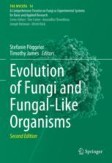Search
Search Results
-
Understand Evolution Better Applying the Computer
The evolution of populations creates new species; the individual living being or protein is, after all, determined within narrow limits by the...
-

-
Organisms Viewed from Real Space and Sequence Space
Biology has a very long history. In the process, much research has been conducted on the classification of organisms, the discovery of...
-
UniAligner: a parameter-free framework for fast sequence alignment
Even though the recent advances in ‘complete genomics’ revealed the previously inaccessible genomic regions, analysis of variations in centromeres...

-
Interpreting Gene Ontology Annotations Derived from Sequence Homology Methods
The Gene Ontology (GO) project describes the functions of the gene products of organisms from all kingdoms of life in a standardized way, enabling...
-
Rapid sequence evolution driven by transposable elements at a virulence locus in a fungal wheat pathogen
BackgroundPlant pathogens cause substantial crop losses in agriculture production and threaten food security. Plants evolved the ability to recognize...

-
Quantitative systems-based prediction of antimicrobial resistance evolution
Predicting evolution is a fundamental problem in biology with practical implications for treating antimicrobial resistance, which is a complex...

-
Easy Not Easy: Comparative Modeling with High-Sequence Identity Templates
Homology modeling is the most common technique to build structural models of a target protein based on the structure of proteins with high-sequence...
-
Evolution of Fungi and Fungal-Like Organisms
Sequence analyses of numerous fungal genomes over the past two decades have provided us with extensive insights into the phylogenetic relationships...

-
Reference Genome Sequence of Flax
Flax (Linum usitatissimum L.) is an economically important fibre and oilseed crop with a relatively small genome size, estimated at 370–455 Mb,...
-
Direct prediction of intrinsically disordered protein conformational properties from sequence
Intrinsically disordered regions (IDRs) are ubiquitous across all domains of life and play a range of functional roles. While folded domains are...

-
In Silico Intensive Analysis for the E4 Gene Evolution of Human Adenovirus Species D
Adenovirus (Ad) is a ubiquitous pathogen capable of infecting a wide range of animals and humans. Human Adenovirus (HAdV) can cause severe infection,...

-
Characterization of centromeric DNA of Gossypium anomalum reveals sequence-independent enrichment dynamics of centromeric repeats
Centromeres in eukaryotes are composed of highly repetitive DNAs, which evolve rapidly and are thought to achieve a favorable structure in mature...

-
Simple sequence repeats drive genome plasticity and promote adaptive evolution in penaeid shrimp
Simple sequence repeats (SSRs) are rare (approximately 1%) in most genomes and are generally considered to have no function. However, penaeid shrimp...

-
Recurrent sequence evolution after independent gene duplication
BackgroundConvergent and parallel evolution provide unique insights into the mechanisms of natural selection. Some of the most striking convergent...

-
Diversity and Evolution of Mitochondrial Translation Apparatus
AbstractThe evolution of mitochondria has proceeded independently in different eukaryotic lines, which is reflected in the diversity of mitochondrial...

-
Convergent evolution of desiccation tolerance in grasses
Desiccation tolerance has evolved repeatedly in plants as an adaptation to survive extreme environments. Plants use similar biophysical and cellular...

-
Mikrosporidien-Genome als Fenster zu deren Evolution
Genomics is a powerful toolkit for unravelling how evolutionary processes drive organisms’ small- and large-scale genetic variation. Several...
-
Structure and Evolution of DNA Transposons of the L31 Superfamily in Bivalves
AbstractThe mobile genetic elements IS630/Tc1/mariner (ITm ) are widespread DNA transposons that make a significant contribution to the evolution of...

-
Post-cellular biotic evolution in a nutshell
The minimum requirements for post-cellular evolution from prokaryotes towards multicellular eukaryotes are outlined. The main steps are: formation of...

